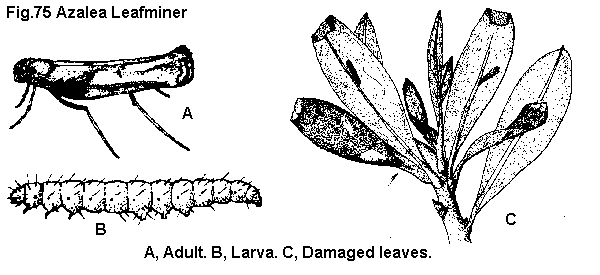DESCRIPTION Adult - The adult azalea leafminer is a small yellow moth with purplish markings on the wings. The wingspread is about 10 to 13 mm. Larva - In the larval stage, the azalea leafminer is a yellowish caterpillar about 7 to 13 mm long. It has three pairs of prolegs found on abdominal segments 3, 4, and 5. The proleg hooks (crochets) on each proleg are arranged in a U-shaped pattern (penellipse) with another series of crochets within the U-shape.
Fig. 75 Azalea leafminer. Caloptilia
azaleella (Brants), Gracillariidae, LEPIDOPTERA BIOLOGY Distribution - The azalea leafminer is found in most states where azaleas are grown. Host Plants - Azaleas are the only known hosts for this insect. Damage - Injury is usually not apparent until brown blisters appear in the leaves or until the tips and margins of leaves are rolled and damaged by feeding larvae inside. Seriously injured leaves usually turn yellow and drop, thereby causing an unsightly plant. Azalea leafminers usually cause little damage in the field but may do considerable damage to cuttings or potted plants being forced into bloom in the greenhouse. Life History - Eggs (usually one to five per leaf) are deposited singly on the underside of the leaf along the midrib. The young larvae hatch in about 4 days, mine into the leaf, and feed between the two leaf surfaces. At this stage the leaf appears to have blisters on it; if it is held up to the light, the larva may be seen inside. When about one third grown, the larva emerges, moves to the tip of a new leaf, and rolls it up for protection while feeding and growing. When nearly grown, the larva rolls up the margin of a leaf and spins a cocoon inside. The moth emerges from the cocoon, mates, and deposits eggs for another generation. Development takes about 6 weeks. Under greenhouse conditions the larva may be found anytime during the year. Outdoors, the insect overwinters as a larva or pupa. Adults appear and females begin to lay eggs about the time azaleas bloom in the spring. CONTROL Because the larva protects itself by mining into and rolling the leaf, this insect is not easy to control. Chemical control is possible if applied at the first sign either of the moths or of foliar injury by the larvae. One or two applications, I to 2 weeks apart should give adequate suppression. For chemical control recommendations, consult the current Cooperative Extension Service publications on ornamental plant pest management. |
